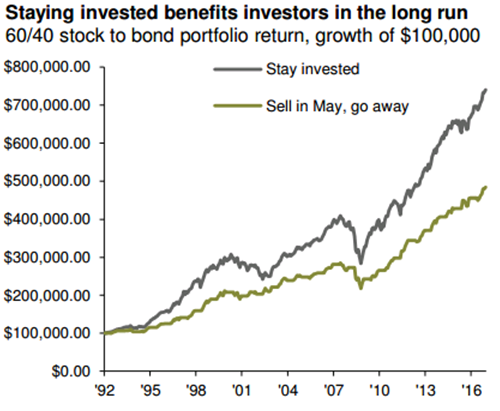 May 2017
May 2017
You’ve likely heard the classic investment mantra to sell in May and go away, meaning to sell your stocks and avoid being invested in the stock market over the summer months. With the S&P 500 Index setting a new all-time high today and stock market volatility plumbing 24-year lows, it stands to reason that we’d hear its refrain in the media this month. The tenacious research folks at J.P. Morgan have published the following analysis on this bit of ill-founded advice. The bottom line is to stay true to your long-term investment strategy through thick and thin. Try not to confuse snappy sayings with investment acumen.
"Now that spring is well underway, the old adage “sell in May and go away” is creeping back into investors’ minds. While the saying is catchy, is it actually sound investment advice? In the equity market, over the last 25 years the period of October 1 to April 30 has outperformed the period of May 1 to September 30, where average monthly total returns for the two time periods have been 1.3% and 0.2%, respectively. However, these numbers can be misleading: while returns during the summer months are low relative to the rest of the year, these months still generate a positive return that investors would be missing out on, exacerbated by the lack of compounding. By adding fixed income to the portfolio, the difference between staying invested and selling in May is magnified. Given that fixed income is negatively correlated with equities, it acts as a buffer in turbulent markets and offers a steady stream of income. All of this considered, an investor in a 60/40 stock and bond portfolio using the “sell in May” strategy would have missed out on $255k over 25 years compared to an investor who stayed the course. Given this, investors should stay disciplined and invested, even through turbulent or slow markets in the long run."

Sources: Standard & Poor’s, Barclays, FactSet, J.P. Morgan Asset Management. 60/40: A balanced portfolio with 60% invested in S&P 500 Index and 40% invested in high quality U.S. fixed income, represented by the Barclays U.S. Aggregate Index. The portfolio is rebalanced annually. 25 year time period is from May 1992 to April 2017.




